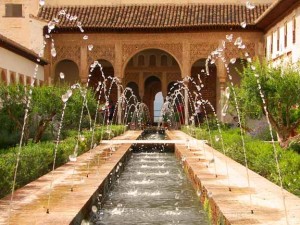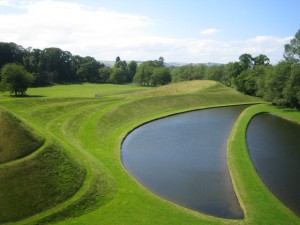
Look around most of our own gardens today and you’re unlikely to find much symbolism. In fact, since around 1700 gardens in Europe have been largely devoid of allegory and metaphor. Instead gardens are more for pleasure and beauty. We aim to create harmonious combinations of flower colours and foliage textures. We want plants of different heights and shapes. We desire visual splendour in the garden throughout the year. The emphasis is on the senses, especially visual impressions. But this is not the only way to think about garden design.
The idea of symbolic garden design has its origins in ancient civilisations. Thousands of years ago the Persians invented the ‘Paradise Garden’. To enter the garden you would have to cross water channels, which represented the four rivers of heaven. Once inside you would find a profusion of fruit trees, symbolic of the fruits of the earth created by God.
Chinese gardens were also full of allegory and meaning. One hundred years before the birth of Christ, the Han Emperor Wei designed a parkland containing artificial lakes and islands to represent an old myth about the dwelling places of immortal beings. In Japanese Zen gardens, rocks were chosen and placed to symbolise man’s passage through the world to eternity. In medieval Europe, too, the plain green lawns in monastic cloisters were considered an important source of spiritual refreshment and contemplation, and symbolised renewal and everlasting life. The design of the renaissance garden of the Villa Lante in Italy represents the tale of humanity’s descent from the Golden Age, based on Ovid’s Metamorphosis.

In the Victorian ‘Language of Flowers’, adopted from an earlier Turkish tradition, flowers were used to symbolise feelings. The meaning of each flower was often based on stories from Greek mythology, Biblical tales or ancient folklore. Examples include snowdrops as a symbol of hope, garden chervil for sincerity, bittersweet for truth, broom for humility, orange trees for generosity and rudbeckia for justice. Some plants had more negative associations: scarlet Auricula for greed, Agnus castus for indifference, and cherry trees for deception.
A related approach is the creation of Shakespeare Gardens – popular in the United States – which contain plants mentioned in the plays. The plants often have symbolic meanings, as in Ophelia’s speech in Hamlet: ‘There’s rosemary, that’s for remembrance. Pray you, love, remember. And there is pansies, that’s for thoughts.’
Symbolic gardens have occassionally appeared at the Chelsea Flower Show. Sir Terence Conran’s Peace Garden commemorated the 60th anniversary of the end of World War II. Plants were selected for their symbolism of peace, war or remembrance, with a predominance of white flowering plants and a scattering of scarlet poppies. Water flowed over a stone wall with the word ‘peace’ written on it in different languages and each pebble in the pool represented a life lost in the war.

The most important contemporary example is Charles Jencks’s ‘Garden of Cosmic Speculation’ in Dumfriesshire, Scotland, which has a DNA garden that is taking symbolic garden design into the future. It contains a series of six cells and in each there is a different kind of idea, which is symbolised by the planting. ‘The planting is subordinate to the design,’ he says, ‘but completes it and fills it out.’
But these recent examples are exceptions. Contemporary garden design remains obsessed with the visual.